The 1793 Yellow Fever epidemic in Philadelphia was devastating for a number of reasons. The toll to humanity was extraordinary: Thousands were killed, and thousands became sick. There were political ramifications, being as Philadelphia was then the nation’s capital, and even President George Washington had to flee Center City. There were medical consequences, considering that Founding Father and Physician Benjamin Rush was baffled by the disease. There were social effects, as Philadelphia’s African American community offered heroic service to their fellow citizens, only to be accused of treachery.
The Historical Society of Pennsylvania has extensive sources that relate to the various aforementioned effects of the epidemic, which can be found here. But, important to this lesson plan (considering that it refers to a relevant source from the Bank of North America collection) is how this epidemic affected the economy, especially banking in Philadelphia – then the financial as well as legal capital of the United States. Students will analyze a fascinating primary source concerning the way in which the epidemic affected the economy.

